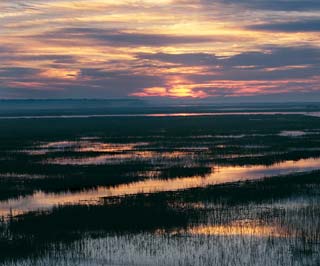Marine - Estuaries
 Considered the most productive ecosystem in the world, estuaries form where sea-water on the flood tide mixes with freshwater in semi-enclosed areas such as Charleston Harbor, Port Royal Sound and Winyah Bay, and behind barrier islands.
Considered the most productive ecosystem in the world, estuaries form where sea-water on the flood tide mixes with freshwater in semi-enclosed areas such as Charleston Harbor, Port Royal Sound and Winyah Bay, and behind barrier islands.
Fresh and salt waters mix in estuaries either as a two layered system with the lighter freshwater on top, or as well mixed waters in areas where the incoming saltwater dominates the freshwater flow from upland rivers and streams.
Salinity in estuaries varies with the height of the tide and the amount of rainfall runoff. Water temperature varies from the upper 40’s in winter to more the mid 80’s in summer.
Strong currents, modified by bottom structure, run through estuaries bringing nutrients from upland and from the adjacent ocean. Incoming ocean currents and tides also bring in the larvae and juveniles of many species of recreational and commercial fish and shellfish.
Tidal creeks that wind through the extensive salt marshes that fringe most estuaries provide ideal nursery areas for larvae and juveniles of many fish species including Atlantic spadefish, black sea bass and cobia. The production of the marsh along with the tidal and riverine currents serve to mix nutrients into a rich soup critical to the development of many species such as shrimp, blue crabs, stone crabs and clams.
Oyster beds develop along the edges of marsh creeks and in some areas grow into large mounds, or oyster reefs, that develop entire estuarine communities, providing both food and shelter for many organisms.
Estuarine fishes include riverine species such as longnose gar and striped bass, as well as many brackish fishes including red drum, spotted seatrout, weakfish and flounder. Warm waters during the spring and summer bring in offshore predators such as bluefish, mackerel, crevalle jack, ladyfish, tarpon, and several sharks.
Bottom feeders including sheepshead, southern kingfish, black drum, spot, croaker, pinfish, and rays consume worms, clams, shrimp and crabs from the rich waters. Wading birds and shorebirds take advantage of shallow water and mud flats at low tide to feed extensively on small fishes and invertebrates. Diving birds such as brown pelicans, Forester’s terns and ospreys also feed in estuaries.
